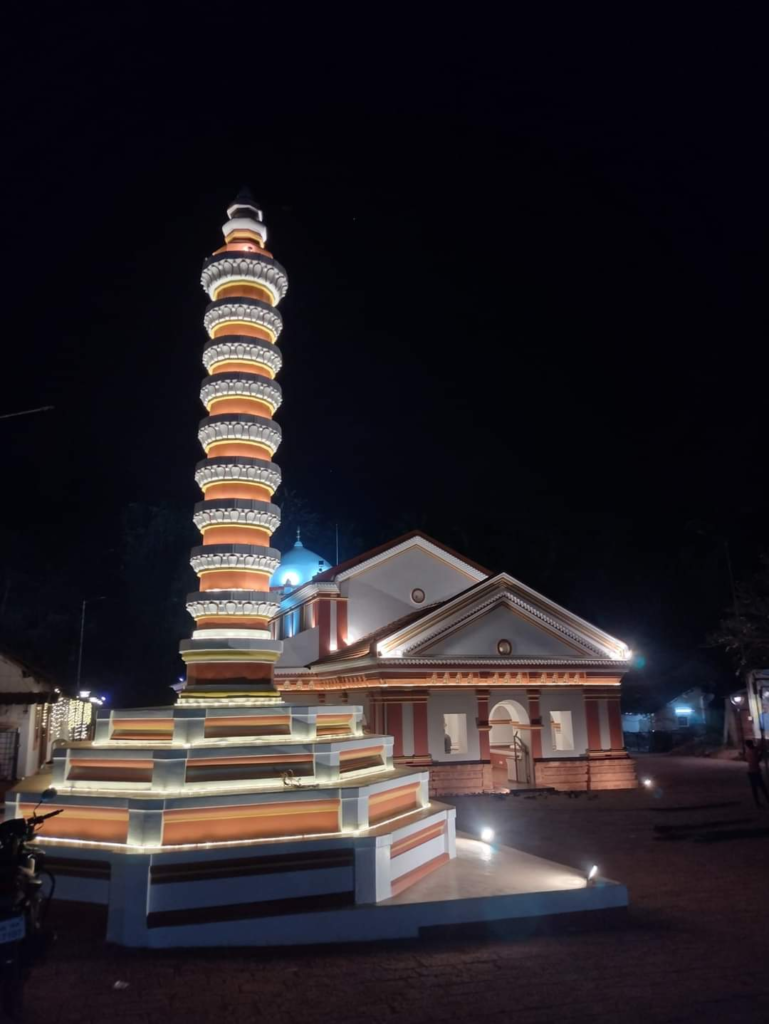
The Saptakoteshwar temple in Narve Goa, has its own place of importance in the history of Goa from ancient times. This temple has seen the glory of Kadambas and Vijayanagaras. And has also witnessed the dark age of Islamic and Portuguese rule. This temple was renovated by the Chhatrapati Shivaji Maharaj- one of the greatest kings of Bharat.
Saptakoteeshwar temple is one of the oldest and holiest of places in Goa. In Sangameshwar Kshetra Mahatmya, there is a mention of ten places in the Konkan region. This temple is mentioned as one of them.
It is believed that seven great rishi did tapasya; at the site of the confluence of the Panchganga river and the sea for 7 crore years to please Lord Shiva. Pleased with their devotion, Lord Shiva appeared to them and offered them a boon. The Rishi’s requested him to make his abode in the same spot and be there for 7 crore or sapt kotee years. Since then, the shiv lingam came to be known as Saptakoteshwar.
According to folklores, Shri Krishna is said to have worshipped at this temple In Dwaparyuga, when he had to escape from Mathura due to Jarasandha’s repeated attacks. After worshipping Lord Shiva here, Shri Krishna established his kingdom at Dwaraka.
The Sahyadri Khand mentions that the temple of Saptakoteshwar is located on an island called Deepvati.
The Kadamba rulers of Goa were the devotees of Shri Saptakoteshwar and they used to refere themselves as “ श्री सप्तकोटीश्वरलब्धवरप्रसाद” (Shri saptkotishwar labdh vara prasad )
In the year 1352, the Bahamani sultan, Gangu Bahamani defeated the Kadambas and conquered Goa. A systematic persecution and conversion of Goan Hindus began under his rule. Many temples were destroyed, including Shri Saptakoteshwar. The Lingam was thrown in a field on the island of Deepvati or Diwadi. But after the rise of the Vijayanagara Empire, a minister of emperor Hariharraya, Madhav Mantri rebuilt it in the year 1391.
After more than 100 years of peace, the Portuguese defeated the forces of Adil Shah and conquered the islands of Goa and Divar in 1510. They were even more fanatical than the Muslims. They destroyed almost all Hindu temples in the territory under their control and built churches there. Saptakoteshwar was one of the first temples to be destroyed. Around 1540, the lingam was removed from the temple and established at the foot of a well. Italian traveller Andre Kosali has mentioned this in his letters to Rome.
A Jesuit priest, Fransico De’Souza mentioned in his book ‘Orienti Conquistado’ published in the late 17th century that Jesuits exulted at the destruction of the temple of Saptakoteshwar. In 1560, more than 1500 Hindus left on the island of Diwar were converted to Christianity and the remains of the temple were completely razed to the ground. A chapel called Candelaria Chapel was built at the same spot in 1563.
Around this time, it is said the Hindu Chieftains from the neighbouring Bhatgram district, Narayan Shenvi Suryarao Desai had a vision in their dream, where Lord Saptakoteshwar directed them to the Lingam and asked them to keep it safe. They took the Shivling from the spot near the well in Divar and transferred it to Narve.

In 1664, the great Hindu ruler, Chhatrapati Shivaji Maharaj conquered the Bhatgram Mahal. When he came to know about the Lingam of Saptakoteshwar, he decided to reestablish the lingam in a new temple and did the Bhoomi-pooja himself. There is an inscription mentioning this restoration of the temple
“ श्रीसप्तकोटीश शके १५९० किलकाब्दे कार्तिक कृष्ण पंचम्यां सोमे श्रीशिवराजा देवालयस्य प्रारंभः”
This devasthan has been recently restored under the Goa Archives and Archaeology Department to retain its glorious history, and cultural identity and celebrate the unwavering faith of people so next time when you are in Goa please visit this temple of Shree Saptakoteshwar in Narve.

The Writer is a teacher by profession. He is also an orator and founder of Yugaantar Goa. The page Yugaantar Goa is dedicated to throwing light on the history and culture of Goa.
